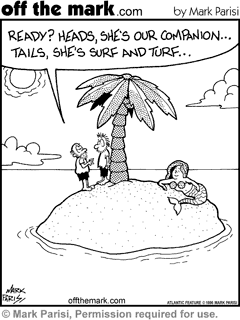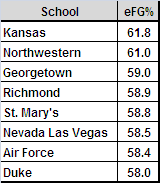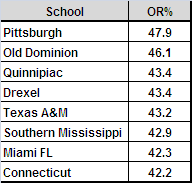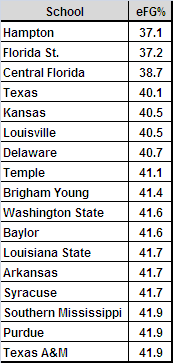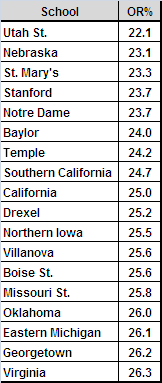Behind the Numbers: The Coming Decline
Posted by KCarpenter on December 15th, 2010So, let’s play a game. I tell you that I’m going to flip a coin (let’s say a 2009 U.S. quarter) exactly thirty times. Your job is to guess how many times that the coin is going to come up “heads.” Very cleverly, you notice that that typically a coin comes up heads about 50% of the time, so you should guess that, in this game, you will get heads about fifteen times. Okay, so I flip the coin the first five times and, surprise of surprises, I end up getting heads four out of five times. Does this mean you were wrong? Does this mean that the coin will continue to turn up heads at a 80% clip? Of course not. It’s just that variance is “magnified“ in small sample sizes. If we flip the coin the full thirty times, it’s almost certainly going to turn up heads less than 80% of the time.
Obviously, we are here not here to talk about flipping coins, but rather college basketball. So, what’s the relevance? The relevance is that right now, we are about a third of the way through the college basketball season and people are pointing to extraordinary statistics and acting as if they are going to hold up through March and April. The coin won’t turn up heads 80% over a big enough sample size, and Pittsburgh won’t continue to grab 47.9% of offensive rebounds against its opponents. Some of the extraordinary stats in college basketball are simply due to small sample size. Some teams tasting truly rarefied air in December are destined to fall back to Earth come March. Who’s due for a decline?
Glad you asked. What I’ve done is checked up on who was the leader on the offensive and defensive ends of the court in regards to each of Dean Oliver’s Four Factors at the end of the 2009-10 season. Then, I checked Ken Pomeroy’s rankings to see which teams were currently performing better than the very best team from last year. The logic is simple (and admittedly a little simplistic): It’s unlikely that many teams this season are going to perform too much better than what the best team in a given category did the year before. Unsurprisingly, at this point early in the season, there are quite a few teams performing better than any team performed last year. Let’s break it down category by category and figure out which teams are cruising for a bruising. Or a decline in efficiency. One or the other.
Effective Field Goal Percentage
None of these teams are shooting that much better than 2009-10 Denver (57.9%), but still, betting on Kansas or Georgetown’s shooting to cool off isn’t a bad bet. It’s a little early to predict Duke’s shooting to decline, but if Kyrie Irving’s absence isn’t explanatory enough for you, here’s another reason.
Turnover Percentage
Let’s ignore this one for now. So far this year, no team has turned the ball over less than Houston did last year (12.4%), though South Dakota State and BYU aren’t far from the mark.
Offensive Rebounding Percentage
Pittsburgh’s current rate of 47.9% is completely unsustainable. A full five percentage points over last year’s best mark, this is a number that is destined to drop. Pitts will be worse on the offensive glass before the year is through. It’s tempting to saw the same thing about Old Dominion’s ridiculous 46.1% mark, but ODU gets a pass: they are the team that led college basketball in offensive rebounding last year.
Free Throw Rate
If you knew Tennessee was hot but didn’t know why, here’s a place to start: Tennessee is getting to the free throw line at a rate that is a full six percentage points better than any team got to the line in 2009-10. That will win a few games. It also won’t last. Tennessee won’t get to the line at this insane rate as the season rolls on and their offensive efficiency will take a hit.
Opponent’s Effective Field Goal Percentage
Syracuse leads a whole pack of teams that are defending slightly better than the very best team from last year (St. Peter’s: 42.8%). A decline is quite possible for either of these teams, though I wouldn’t be too surprised or think it unreasonable if any of these teams maintained their defensive efficiency. Of course, if someone happened to figure out the trick to a particular team’s defense, like, oh I don’t know, Syracuse’s, then a decline might very well be in the offing.
Opponent’s Turnover Percentage
Apparently, turnover percentage might be pretty stable. Only two teams are forcing turnovers at a rate that’s better than last year’s 28.3% mark set by Delaware, and Oregon State’s mark of 29.9% and and Stephen F. Austin’s 28.3%, while impressive, don’t seem unreasonably or unsustainably high. Still, Oregon State fans would do well to not count on this incredible rate of turnovers all season.
Opponent’s Offensive Rebounding Percentage
A whole clutch of teams are getting defensive rebounds at rates that are significantly better than last year’s high water mark of 26.3% (shared by Penn State and Wisconsin). While Utah State and Temple had phenomenal success on the defensive glass in the past year, making their presence on this chart a little more understandable, some of these other teams are more suspect. For starters, I would expect a decline on the glass from Notre Dame, Nebraska and St. Mary’s.
Defensive Free Throw Rate
Only a single team has managed to foul less than last year’s Siena team, and that’s Ohio State. This is totally unsurprising as Ohio State has consistently fouled the least of any team over the past five years. Don’t expect the Buckeyes to suddenly start hacking.





























